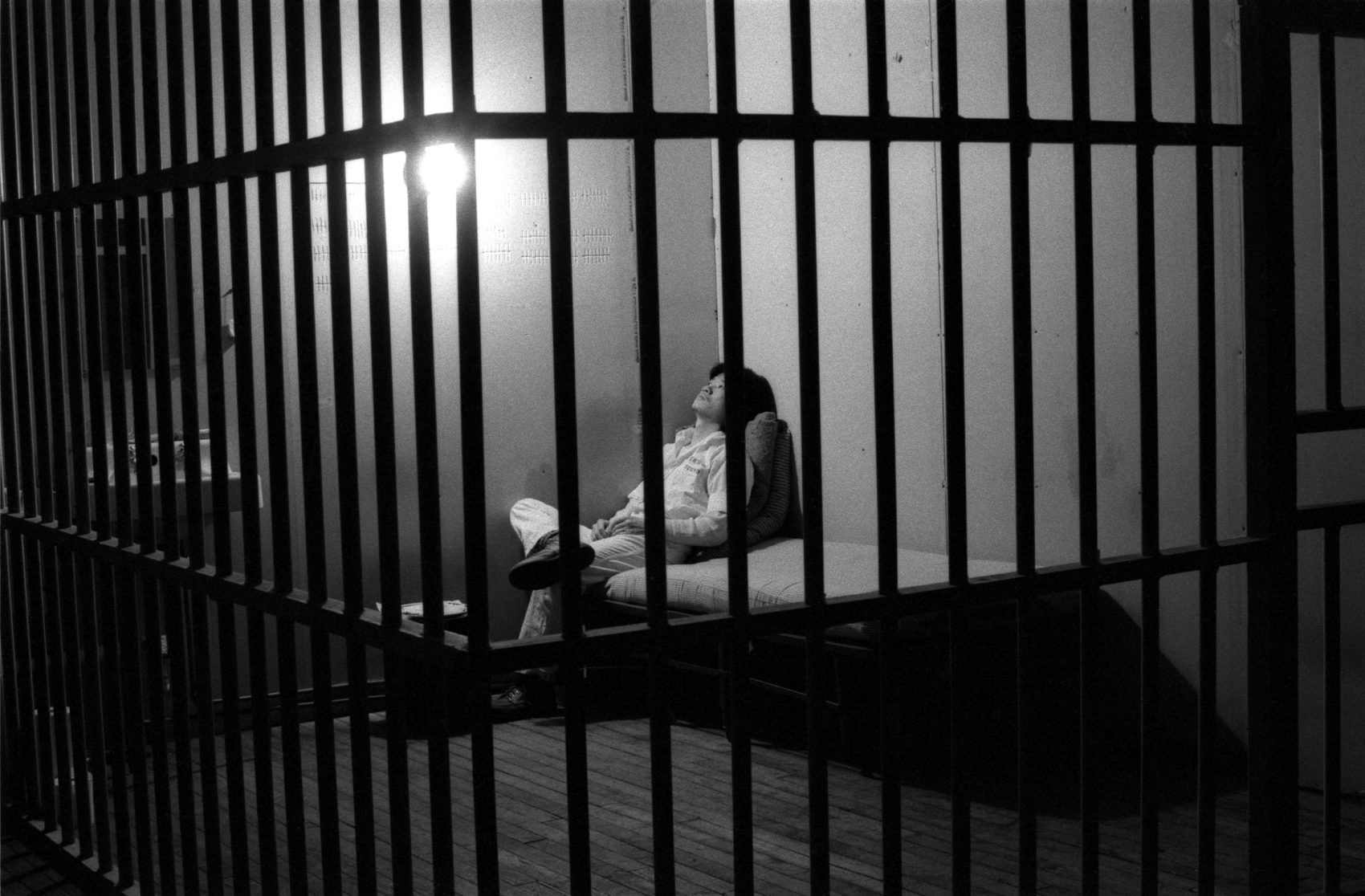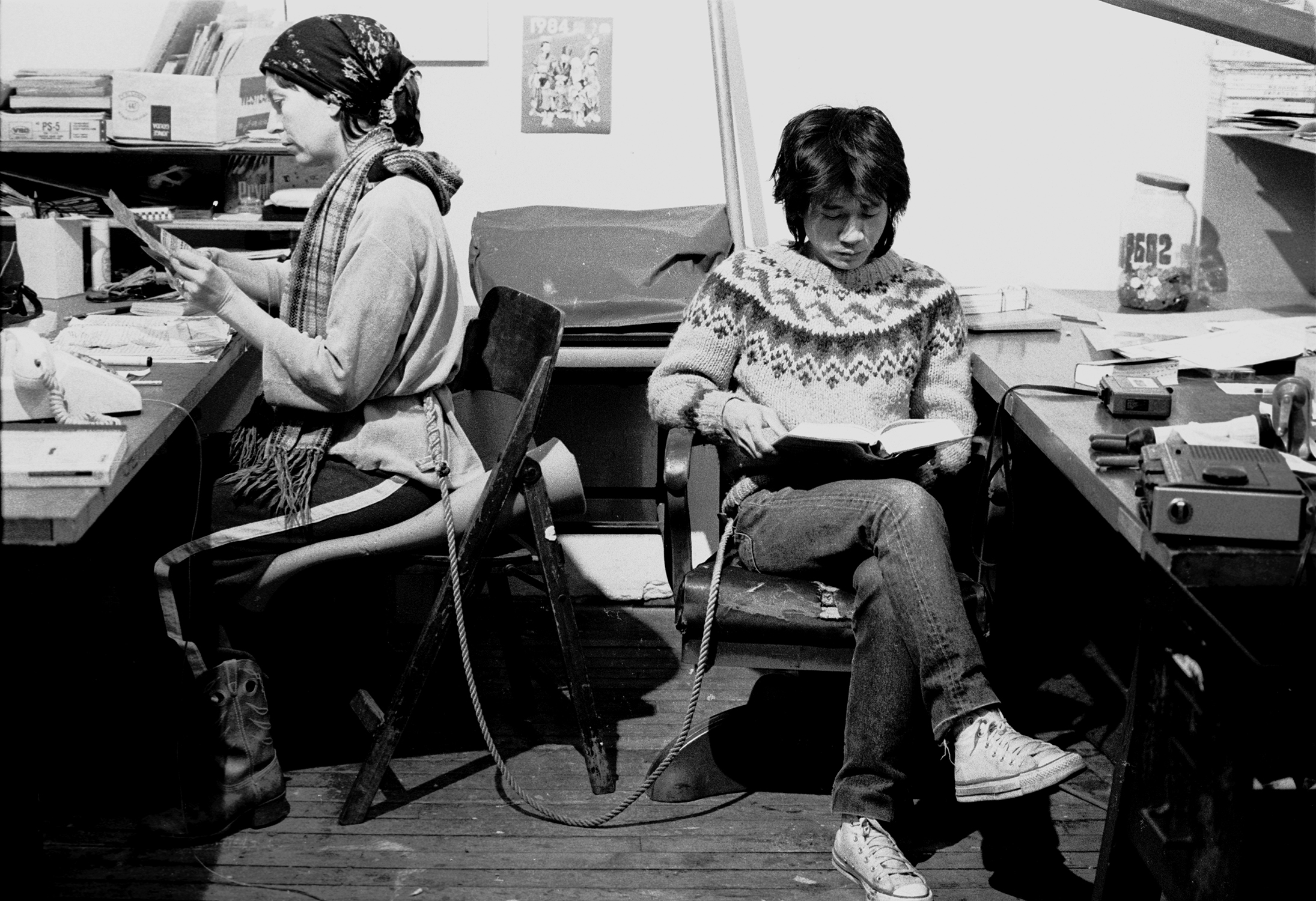The Dash column explores art and its social contexts. The dash separates and the dash joins, it pauses and it moves along. The dash is where the viewer comes to terms with what they’ve seen. Here, X-TRA editor Anuradha Vikram relates her experience teaching university students in a time of quarantine and protest.

Tehching Hsieh, One Year Performance 1978–1979 (Cage Piece), 1978–79. Life Image. © Tehching Hsieh. Courtesy of the artist.
Each week, for the twelve weeks that I met with my undergraduate students on Zoom, I got a window into their private lives and opened one into my own. After the UCLA campus shut down abruptly on March 10, my students scattered: some to tight quarters with their parents, some to deserted dorms. Two traveled internationally and got caught in border quarantine for fourteen days. I’ve always been transparent in the classroom about my life as a working parent. Part of my pedagogy is showing up as my whole self for every professional and personal endeavor. Even so, I never expected to be shielding my four-year-old’s face from the camera in my home office.
The personal anxiety of inviting the public university into my home every day was paralleled by the greater anxiety the public as a whole has been feeling, to varying degrees, due to the virus and the financial catastrophe enabled by our national lack of response. In the university, though, despite the impression of normality, instability and fear were already apparent before the lockdown. On February 8, UC Santa Cruz fired fifty-four graduate student workers who had organized a wildcat strike at the end of winter quarter. The first few weeks of spring had been peppered with solidarity actions across the University of California (UC) that foregrounded the high cost of living for teaching assistants (TAs) system wide. Graduate students at UC Santa Barbara and UC Davis threatened strikes to demand a badly needed pay increase to match the rising cost of rent near California campuses, including UCLA. My own course depends on four graduate TAs who run discussion sections and support student welfare and learning. They have more than demonstrated their essential value during the pandemic.
My first online art history lecture, which I had originally prepared for in-person delivery during winter quarter, included over fifty slides. I quickly learned that three hours of synchronous lecture is torture for instructor and students alike. The body needs more breaks during a video call. When my throat and my teacup ran dry, about every forty-five minutes, I came to recognize this as a sign that the students also needed to rest. For my first class of the (fully online) spring quarter, I gave a half-hour overview and a forty-five-minute lecture, had the students break out into discussion groups for twenty minutes, then gave them a forty-minute break to review the online resources and discussion boards I had compiled for the course. We met at the end for a twenty-minute Q&A. I added a final group assignment in the hope that the students would find some interpersonal connection despite the alienation inherent in the online setup.
Perhaps because the institution expressed an unprecedented level of concern for their welfare, the students mostly produced excellent academic and creative work. For some, immersion in contemporary art by artists who resemble them in complexion and personal history became a source of solace. I feel fortunate that, after two quarters covering 200 years of global modern art history, my students had the broad perspective to click immediately with the works of contemporary artists. My undergrads responded to Arthur Jafa, ASCO, David Hammons, Tehching Hsieh, and Carrie Mae Weems in their final projects—artists who express race and embodied consciousness through elegant conceptual gestures.
The first four of Tehching Hsieh’s One Year Performance works, made between 1978 and 1984, are particularly resonant as they anticipate facets of our strange moment of confinement and protest. In the first, One Year Performance 1978–1979 (Cage Piece), Hsieh confined himself to a wooden cage constructed inside his apartment and lived removed from social or media stimulus, dependent on a caregiver to provide his food, remove his waste, and document the daily action. This work reflected on the artist’s then-undocumented status, but also on the social isolation felt by the immigrant, the invalid, or the prisoner. The next work, One Year Performance 1980–1981 (Time Clock Piece), required Hsieh to punch a time clock every hour of the day and night as he went about his activities. The work includes a table listing all of the artist’s punches and the reasons he missed them, including sleep. As I go about my day, broken up into teaching, class preparation, writing, and homeschooling shifts, all in the same limited space, I think about how Hsieh regimented his mind to the clock. It’s telling that the artist became less diligent as the year progressed, then reinvigorated in the home stretch.
Hsieh’s third work, One Year Performance 1981–1982 (Outdoor Piece), gnaws at me as a person with the luxury of a home to live and work within. The artist remained outside for one year, never entering buildings or taking shelter. His voluntary homelessness may have been a cover for his genuine poverty, as Hsieh has spoken honestly about his financial and immigration challenges during this period. Joan Kee has argued that Hsieh’s One Year Performances function as legal validations of a life lived extralegally because the artist’s instructions to himself in written form use the language of contracts to make his peripheral experiences into something concrete. Los Angeles’s housing crisis has become even more apparent during the quarantine, as people living on the street lack access to hygiene needed to prevent the spread of COVID-19 and have already been susceptible to typhus and other illnesses. Downtown, where it seems unlikely that we can return to normal activities any time soon, the unsheltered population numbers close to 5,000; meanwhile, fewer than 8,000 people statewide had been able to take advantage of vacant hotel room placements as of mid-May.
I do not know if any of my students are unsheltered. I know that less than half seem to have access to a stable enough internet connection and a quiet enough place to work that they are able to turn their cameras and microphones on during class. Students are being affected by changes to immigration and Title IX enforcement on campus. I don’t require that the students be visible so long as they are making a good showing in our online discussion boards and in discussion section with the TAs. I know many colleagues who feel that audio and video should be mandatory for undergraduate students because their courses depend on having everyone’s synchronous attention. I have had to accept that this may not be realistic given the instances of trauma I’m seeing.

Tehching Hsieh, Art/Life One Year Performance 1983–1984 (Rope Piece), 1983–84. Life image. © Tehching Hsieh and Linda Mary Montano. Courtesy of the artist.
Hsieh is perhaps best known for One Year Performance 1983–1984 (Rope Piece), for which he collaborated with performance artist Linda Mary Montano. Their art/life experiment is an inversion of our post-COVID future—two strangers, bound to stay within six to eight feet of one another for a whole year. Literally tethered together, the artists were forced to negotiate one another in all things. I think of them when my husband laughs heartily on a Zoom call from the desk a few feet over while I struggle to quiet my mind enough to write art criticism in the few short moments between requests from our two young kids.
I was blessed by Montano, the self-described “Art Saint,” when she made an appearance in my graduate seminar for USC Roski in late March. Despite two separate meetings to troubleshoot tech issues, something went awry shortly into the class and Montano was no longer able to see me or the students (we could still see her). No matter. She had asked us each to prepare a one-minute performance for the camera based on studying one of her previous performance works. I chose Three Day Blindfold/How to Become a Guru (1975). “In this event,” Montano writes, “I blindfolded myself because I didn’t want to react visually or socially and thought that I could alter my perceptions and therefore drop habituation and judgment.” I draped my head and face with a shawl covered in big gold sequins and meditated for sixty seconds. I named gold as my chakra color, which symbolizes the solar plexus. Vedic tradition calls this the center of confidence, dynamism, and will. This part of the body is associated with digestion and is also the home of “gut intelligence” in the form of the complex human microbiome. It seemed to me an inappropriate time to be guided by the head or the heart.
On May 1st, UC faculty joined a May Day General Strike in solidarity with essential frontline workers and graduate students striking for cost of living adjustments. The night before, I recorded the lecture I would normally give in class and posted it online for students to review independently. From April 17 to May 1, discussion board activity for the class dropped from thirty-five out of fifty-two students responding to twenty-two out of fifty-two. Three weeks later, there was little improvement. Our experiment with asynchronous learning seemed to have severed the already tenuous engagement of some students. Fortunately, toward the end of class, the students resurfaced, thanks to the group project that served its purpose of maintaining connection beautifully. The genuine pride students felt for one another on completing the project and the class was matched by their excitement about their peers’ inventive and creative presentations.
Scientific philosopher Giorgio Agamben has lamented how the shift to online learning results in “the disappearance of group discussion in seminars, which was the liveliest part of instruction.” Mourning the loss of campus life, he describes how scholars in a community of knowledge are being replaced by atomized, dispersed learners “closed up in their rooms.” He imagines that university towns will be diminished by the disappearance of students. I feel his lament is bound to an old reality, one that maybe never existed, certainly not in my lifetime. In Agamben’s world, students could afford tuition and housing without having to seek service jobs in town. He omits those students who were the first in their families to access higher education, who often had to leave their communities to do so, and who feared losing their hard-won social legibility if they returned with the knowledge they gained. An ideal community of scholars is one where every participant is secure in their legal status as a whole person and a citizen.
Online learning has its drawbacks, but many could be addressed with improved access to internet, shelter, and other basic amenities. One potential benefit is the loss of “town and gown” divisions that cast knowledge and service workers as different populations. Another is the end of elitism as a value, maintained by faculty who act as gatekeepers to private networks that undergird the ivory tower. These will likely lose influence absent extracurricular opportunities to curry favor with well-connected students. This is a cause for rejoicing. Students’ relationships to peers and mentors, and to learning, will endure. X

Anuradha Vikram is a curator, writer, and educator based in Los Angeles. She is the author of Decolonizing Culture (Art Practical/Sming Sming Books, 2017) and a guest editor of the recent Asian Diasporic Visual Cultures and the Americas special issue, “Challenging Hegemony within the South Asian Diaspora” (Brill, Fall 2019).